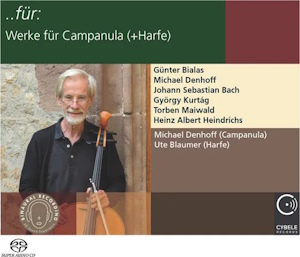
..für: Werke für Campanula (+Harfe)
Michael Denhoff (campanula)
Ute Blaumer (harp)*
rec. 2023, Alte Kirche auf dem Rymelsberg, Langerweht, Germany
Cybele 362404 SACD [74]
The recently invented campanula is a cello-like instrument with additional resonating strings that add a subtle halo of sound beyond conventionally bowed sonorities. As soloist on this recording Michael Denhoff has brought together a fine collection of new works for his instrument by composers with whom he has, or had, personal friendships, as well as a hint of Bach and three of his own pieces.
Günter Bialas’ Albumblatt G5 serves as a good introduction to the campanula, with its wide range of techniques alongside conventional lyrical lines. It’s sometimes hard to tell which resonances come from the instrument as the church acoustic is equally rich and reflective, but what we hear is certainly a fine sound that extends into Denhoff’s Melodienprojekt. This is a set of pieces that take a single melody line with variations in treatment that range from performance in canon with a delayed electronic playback, or with the notes enhanced by the harp to create something fascinatingly meditative. There are more impactful statements that play dramatically on acoustic effects both from the instrument and its surroundings, and while abstract these also project a sense of vocal utterance and always have a sense of communication with the listener. These are pieces that follow that strong tradition of player/composer, in music by one who is clearly at one with his instrument and who is delivering highlights from a long voyage of discovery.
Johann Sebastian Bach’s Sarabande from the D minor Suite BWV 1008 appears at the centre the programme, and we are invited to hear it as a ‘bridge’ between the other works, “a dance movement lost in itself and removed from time” indeed, and certainly in this elegantly ruminative performance. György Kurtág’s Signs, Games and Messages emerges from the Bach in a connected mode, initially softening the dissonances of the first of three brief movements that range from gruff folk-tones to enigmatic, gloomily suggestive mystery. Originally for cello, Torben Maiwald’s An Wesen is “a quiet – almost meditative monologue addressed to (living or spiritual) beings.”
Denhoff’s Acht Intermezzi is where the campanula and harp dialogue really shines in this programme. His own description is of “eight sketchy miniatures, as it were interludes or reflections on poetic moods and moments, such as can be triggered by reading haikus.” Atmosphere is joined by a certain amount of virtuosity here, though any intensity in the music is always ‘open’ and receptive to the imagination of the listener. Plucked harp strings and enhanced-cello resonances work superbly in these pieces and one can imagine an entire extended theatre of the imagination descending from such dynamically impressive sketches.
Heinz Albert Heindrichs’ Atem für Atem is also based on poetry, with his poem of the same name printed in the booklet. Breath and air are reflected in expanding notes and upper harmonics, but as the booklet notes describe, the music “goes beyond the poem” and, while the two co-exist, they also live independent lives. To close the programme, Denhoff’s Inner minds connect to visual art in the form of sculptures by Wolfgang Überhorst. Again, it’s nice to know the background to such pieces, but unless one has experienced the artworks they exist outside our experience. In this case the campanula finds itself in a movingly expressive dialogue with a kind of heavenly cousin, conjuring counter-melodic notes in an upper range beyond the more active soloist.
Many of us reviewers come across recordings of new music, and many of these recordings are listened to, appreciated for what they are, but in reality almost always set aside never to be played again. In this case we have what I would call a ‘keeper’, something that I know I will want to have around for the particular sonorities and atmosphere of both the campanula and the fascinating music brought together on this superbly recorded disc. To be sure, you have to invest some of yourself; allow this music its time and give it your full open-minded attention, but is that not the case with all good music?
Dominy Clements
Buying this recording via a link below generates revenue for MWI, which helps the site remain free


Contents
Günter Bialas (1907-1995)
Albumblatt G5 (1985)
Michael Denhoff (b. 1955)
From: Strophen – das Melodienprojekt Op. 107 (2009)
Johann Sebastian Bach (1685-1750)
Suite Nr. 2 in D minor BWV 1008 – Sarabande
György Kurtág (b. 1926)
From: Signs, Games and Messages (1987-2000)
Torben Maiwald (b. 1978)
An Wesen (2006)
Michael Denhoff
Acht Intermezzi op. 112 (2014)*
Heinz Albert Heindrichs (1930-2021)
Atem für Atem (2002)
Michael Denhoff
Inner minds op. 117 (2017)
















